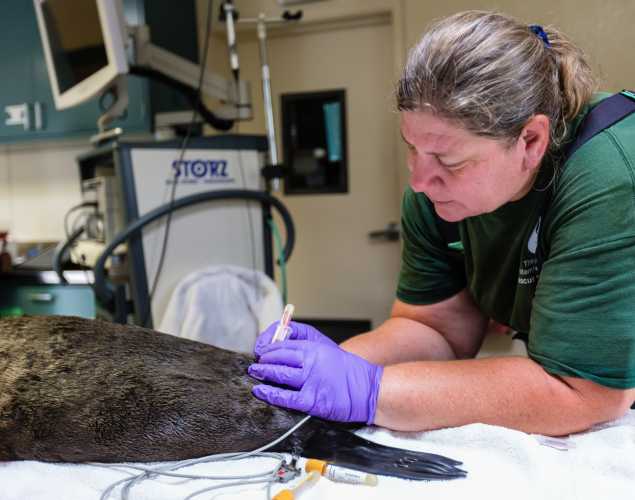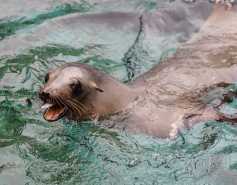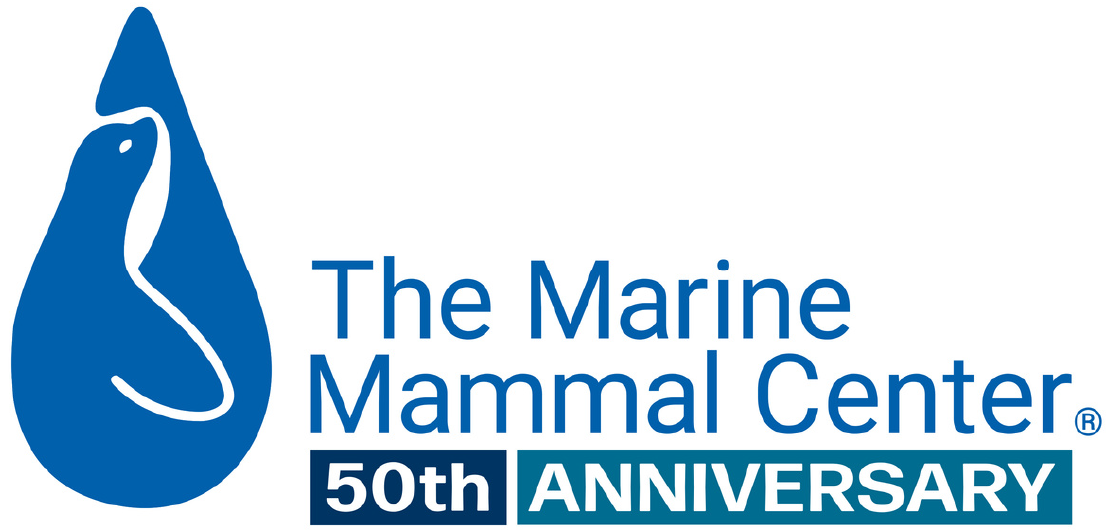
Evaluating Diagnostic Tools for White Blood Cell Counts in Pinnipeds
Abstract
Point of care (POC) hematology testing can be valuable in triage and field settings. We assessed the accuracy between the HemoCue® WBC system and two comparative analyzers, as well as the precision of the HemoCue® WBC system in five different pinniped species: Zalophus californianus, Arctocephalus townsendi, Callorhinus urcinus, Phoca vitulina, and Mirounga angustirostris for white blood cell (WBC) quantification. In Zalophus (n = 164; 106 from U.S. Navy Marine Mammal Program (Navy); 58 from The Marine Mammal Center (TMMC)), the HemoCue® was compared to two hematology analyzers, Sysmex Xe-5000 and Vet ABC Plus. In Phoca (n = 50; TMMC), Callorhinus (n = 29; TMMC), Arctocephalus (n = 17; TMMC), and Mirounga (n = 67; TMMC), the HemoCue® was compared to Vet ABC Plus only. Bland–Altman and Passing–Bablok agreement of HemoCue® with Sysmex Xe-5000 and Vet ABC Plus analyzers were good for Zalophus, Arctocephalus, Phoca, and Mirounga but marginal with Callorhinus; bias = 0.56 × 109/L (Zalophus; Navy), −2.13 × 109/L (Zalophus; TMMC), −1.59 × 109/L (Arctocephalus), −2.48 × 109/L 0.917 (Phoca), −0.01 × 109/L (Mirounga), and −6.05 × 109/L (Callorhinus). The coefficient of variation from triplicate runs of samples were within acceptable limits for all species (2.50% ± 1.63 (Zalophus; TMMC), 3.09% ± 2.14 (Arctocephalus), 2.47% ± 1.35 (Callorhinus), 2.88% ± 1.75 (Phoca), and 3.44% ± 2.53 (Mirounga)), respectively. The presence of nucleated red blood cells (nRBC; 1–37 nRBC/100 WBC) did not significantly interfere with WBC counts in Zalophus, Callorhinus, and Phoca at the population level, but their presence should be evaluated at the individual level. The HemoCue® provides an accurate method for WBC quantification with WBC counts up to 30 × 109/L (upper limit of linearity of the analyzer) in Zalophus, Arctocephalus, Phoca, and Mirounga, but is less accurate in Callorhinus, and showed good precision in all species.
McClain, A. M., Whitmer, E. R., Rios, C., Jensen, E. D., Stacy, N. I., & Johnson, S. P., 2022. Evaluation of the HemoCue® WBC System as a Point of Care Diagnostic Tool for White Blood Cell Quantification in Pinnipeds. Oceans, 3(1), pp. 72-83.
Related Publications
{"image":"\/Animals\/Patients\/California sea lions\/csl-by-bill-hunnewell-c-the-marine-mammal-center-1.jpg","alt":"California sea lion eating a fish","title":"New Technique for Diagnosing Lung Parasite Infections in Sea Lions","link_url":"https:\/\/www.marinemammalcenter.org\/publications\/new-technique-for-diagnosing-lung-parasite-infections-in-sea-lions","label":"Research Paper"}

{"image":"\/Animals\/Patients\/Elephant seals\/cropped-images\/es-by-bill-hunnewell-c-the-marine-mammal-center-3-2-1214-3454-3512-1600891002.jpg","alt":"northern elephant seal","title":"Diagnostic Tests for Lungworm-Infected Northern Elephant Seals","link_url":"https:\/\/www.marinemammalcenter.org\/publications\/diagnostic-tests-for-lungworm-infected-northern-elephant-seals","label":"Research Paper"}

{"image":"\/Animals\/Wild\/Other species\/cropped-images\/fin-whale-fort-funston-by-barbie-halaska-c-the-marine-mammal-center-259-328-3782-2954-1619455378.jpg","alt":"","title":"Analyzing Stress and Reproductive Steroid Hormones in Gray and Fin Whales","link_url":"https:\/\/www.marinemammalcenter.org\/publications\/analyzing-stress-and-reproductive-steroid-hormones-in-gray-and-fin-whales","label":"Research Paper"}

{"image":"\/Animals\/Patients\/California sea lions\/2022\/cropped-images\/csl-currie-by-bill-hunnewell-c-the-marine-mammal-center-1678-86-2028-1584-1647881784.jpg","alt":"California sea lion","title":"Investigation of the Use of Serum Biomarkers for the Detection of Cardiac Disease in Marine Mammals","link_url":"https:\/\/www.marinemammalcenter.org\/publications\/investigation-of-the-use-of-serum-biomarkers-for-the-detection-of-cardiac-disease-in-marine-mammals","label":"Research Paper"}

Investigation of the Use of Serum Biomarkers for the Detection of Cardiac Disease in Marine Mammals
Read MoreRecent News
{"image":"\/Animals\/Patients\/Hawaiian monk seals\/2025\/cropped-images\/d-ru28release-exam-at-ke-kai-ola111025photo-by-giancarlo-rulli-c-the-marine-mammal-center-noaa-permit-24359-0-0-1270-992-1764620886.jpg","alt":"","title":"Bird Flu Vaccine Trial Offers Hope for Protecting Hawaiian Monk Seals","link_url":"https:\/\/www.marinemammalcenter.org\/news\/bird-flu-vaccine-trial-may-offer-hope-for-protecting-hawaiian-monk-seals","label":"News Update","date":"2025-12-01 08:13:00"}

Bird Flu Vaccine Trial Offers Hope for Protecting Hawaiian Monk Seals
December 1, 2025
Read More{"image":"\/Animals\/Patients\/Hawaiian monk seals\/2021\/hms-pp08-by-sheila-latta-c-the-marine-mammal-center-noaa-permit-18786.jpg","alt":"Hawaiian monk seal","title":"The New York Times: Inside the Bird-Flu Vaccine Trial for Monk Seals","link_url":"https:\/\/www.marinemammalcenter.org\/news\/the-new-york-times-inside-the-bird-flu-vaccine-trial-for-monk-seals","label":"In the News","date":"2025-12-01 01:00:00"}

The New York Times: Inside the Bird-Flu Vaccine Trial for Monk Seals
December 1, 2025
Read More{"image":"\/Animals\/Wild\/Sea otter\/so-wild-morro-bayphoto-c-brian-simuro-20.jpeg","alt":"Sea otter and pup","title":"Watch a Sea Otter Pup Reunite With Its Mother","link_url":"https:\/\/www.marinemammalcenter.org\/news\/watch-sea-otter-pup-reunite-with-its-mother","label":"News Update","date":"2025-11-14 10:35:41"}

{"image":"\/Animals\/Wild\/Sea otter\/sea-otter-photo-c-brian-simuro.jpeg","alt":"Sea otter","title":"AP News: Baby sea otter is reunited with mother in central California after dramatic rescue","link_url":"https:\/\/www.marinemammalcenter.org\/news\/ap-news-baby-sea-otter-is-reunited-with-mother-in-central-california-after-dramatic-rescue","label":"In the News","date":"2025-11-14 09:46:34"}

AP News: Baby sea otter is reunited with mother in central California after dramatic rescue
November 14, 2025
Read More
